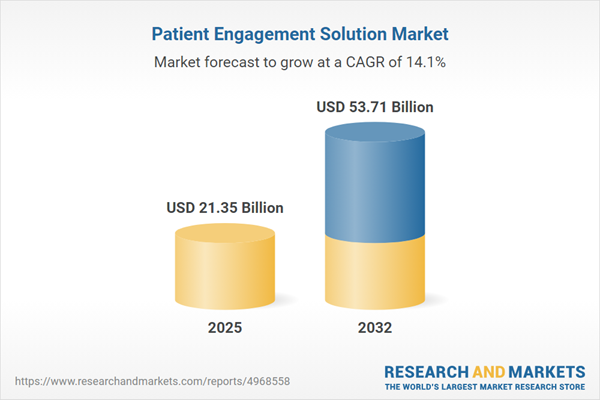Speak directly to the analyst to clarify any post sales queries you may have.
The patient engagement solution market is redefining how healthcare leaders approach operational efficiency, compliance, and patient-centered care. Senior decision-makers are adopting advanced digital technologies to align care delivery with evolving industry expectations and regulatory compliance demands.
Market Snapshot: Patient Engagement Solution Market
The global patient engagement solution market continues to accelerate as organizations transition to digital-first healthcare models. Revenue is projected to rise from USD 18.66 billion in 2024 to USD 21.35 billion in 2025, with long-term expectations reaching USD 53.71 billion by 2032 and a compound annual growth rate (CAGR) of 14.12 percent. This expansion is fueled by secure and interoperable platforms that enable providers to manage shifting care delivery approaches, facilitate real-time coordination, and address increasingly complex regulatory frameworks. Cloud-based and mobile technologies empower care teams with flexible, personalized engagement capabilities, supporting both operational improvements and a continuous cycle of innovation.
Scope & Segmentation
- Component: Technology services support healthcare organizations in optimizing platforms through consulting, implementation, and ongoing support, while software delivers telehealth, dynamic scheduling, and secure clinical communications for patients and care teams.
- Delivery Mode: Private cloud environments ensure robust data protection suitable for confidential health information, public cloud deployments allow rapid scaling for diverse population needs, and on-premise solutions remain relevant for organizations needing direct infrastructure control or accommodating legacy systems.
- End User: Hospitals, clinics, payer groups, and various care providers are adopting digital engagement to improve team collaboration, streamline administrative and clinical workflows, and support both broad population health initiatives and personalized patient care.
- Application: Mobile applications, web-based portals, and interconnected medical devices are driving ongoing patient participation, strengthening remote monitoring capabilities, and integrating clinicians, caregivers, and patient interactions across digital channels.
- Region: The Americas are at the forefront due to strong regulatory frameworks, while Europe, the Middle East, and Africa reflect differing levels of digital readiness. Asia-Pacific’s growth is shaped by both compliance complexities and opportunities for technological innovation.
- Leading Companies: Major solution vendors such as Epic Systems Corporation, Cerner Corporation, Allscripts Healthcare Solutions, Koninklijke Philips N.V., McKesson Corporation, NextGen Healthcare, GetWellNetwork, Welltok, Medisafe, and Conversa Health lead with healthcare integration expertise and ongoing strategic partnerships.
Key Takeaways
- Integrated engagement solutions are supporting seamless collaboration between care teams, boosting the consistency and accuracy of patient data management within clinical workflows.
- Organizations benefit from flexible deployment options that aid in maintaining compliance while ensuring efficient performance at varying operational scales, from small practices to large health systems.
- Artificial intelligence is enhancing solution capabilities, delivering customized interactions and actionable insights for both patient care improvement and operational streamlining.
- Advanced analytics are broadening the impact of remote care and expanding digital engagement opportunities, notably via mobile platforms in rapidly developing markets.
- Industry-wide cooperation among solution vendors, device manufacturers, and policymakers is vital for building secure digital infrastructures and driving interoperability across diverse healthcare ecosystems.
Tariff Impact: 2025 U.S. Policy Developments
The latest U.S. tariff policy updates have led to increased costs for telehealth and remote monitoring solutions. In response, healthcare organizations are prioritizing collaboration with domestic technology firms and accelerating migration to robust, cloud-based engagement platforms. Vendors are recalibrating pricing structures and updating service offerings to safeguard continuity of patient engagement efforts in an evolving regulatory environment.
Methodology & Data Sources
This report integrates comprehensive industry surveys, direct feedback from key stakeholders, and regulatory landscape analysis. Data quality is assured through expert validation and triangulation methods, ensuring the integrity and reliability of findings.
Why This Report Matters
- Senior decision-makers will find actionable insights for guiding strategic investments in patient engagement solutions, which enable agile, patient-focused healthcare operations.
- The report equips procurement and compliance professionals with performance benchmarks and regulatory guidelines to strengthen workflow optimization and standards adherence.
- Organizations can leverage data-driven recommendations to achieve digital leadership, improve patient interaction metrics, and foster resilience in healthcare transformation initiatives.
Conclusion
Patient engagement solutions have become essential in fostering healthcare modernization and adapting to new regulatory and market realities. Continued investment in digital engagement empowers organizations to stay agile and patient-focused in a dynamic landscape.
Additional Product Information:
- Purchase of this report includes 1 year online access with quarterly updates.
- This report can be updated on request. Please contact our Customer Experience team using the Ask a Question widget on our website.
Table of Contents
3. Executive Summary
4. Market Overview
7. Cumulative Impact of Artificial Intelligence 2025
Companies Mentioned
The companies profiled in this Patient Engagement Solution market report include:- Epic Systems Corporation
- Cerner Corporation
- Allscripts Healthcare Solutions, Inc.
- Koninklijke Philips N.V.
- McKesson Corporation
- NextGen Healthcare, Inc.
- GetWellNetwork, Inc.
- Welltok, Inc.
- Medisafe, Inc.
- Conversa Health, Inc.
Table Information
| Report Attribute | Details |
|---|---|
| No. of Pages | 180 |
| Published | November 2025 |
| Forecast Period | 2025 - 2032 |
| Estimated Market Value ( USD | $ 21.35 Billion |
| Forecasted Market Value ( USD | $ 53.71 Billion |
| Compound Annual Growth Rate | 14.1% |
| Regions Covered | Global |
| No. of Companies Mentioned | 11 |









